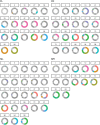Shedding dynamics of a DNA virus population during acute and long-term persistent infection
- PMID: 40408506
- PMCID: PMC12136464
- DOI: 10.1371/journal.ppat.1013083
Shedding dynamics of a DNA virus population during acute and long-term persistent infection
Abstract
Although much is known of the molecular mechanisms of virus infection within cells, substantially less is understood about within-host infection. Such knowledge is key to understanding how viruses take up residence and transmit infectious virus, in some cases throughout the life of the host. Here, using murine polyomavirus (muPyV) as a tractable model, we monitor parallel infections of thousands of differentially barcoded viruses within a single host. In individual mice, we show that numerous viruses (>2600) establish infection and are maintained for long periods post-infection. Strikingly, a low level of many different barcodes is shed in urine at all times post-infection, with a minimum of at least 80 different barcodes present in every sample throughout months of infection. During the early acute phase, bulk shed virus genomes derive from numerous different barcodes. This is followed by long term persistent infection detectable in diverse organs. Consistent with limited productive exchange of virus genomes between organs, each displays a unique pattern of relative barcode abundance. During the persistent phase, constant low-level shedding of typically hundreds of barcodes is maintained but is overlapped with rare, punctuated shedding of high amounts of one or a few individual barcodes. In contrast to the early acute phase, these few infrequent highly shed barcodes comprise the majority of bulk shed genomes observed during late times of persistent infection, contributing to a stark decrease in bulk barcode diversity that is shed over time. These temporally shifting patterns, which are conserved across hosts, suggest that polyomaviruses balance continuous transmission potential with reservoir-driven high-level reactivation. This offers a mechanistic basis for polyomavirus ubiquity and long-term persistence, which are typical of many DNA viruses.
Copyright: © 2025 Blois et al. This is an open access article distributed under the terms of the Creative Commons Attribution License, which permits unrestricted use, distribution, and reproduction in any medium, provided the original author and source are credited.
Conflict of interest statement
The authors have declared that no competing interests exist.
Figures










Update of
-
Shedding dynamics of a DNA virus population during acute and long-term persistent infection.bioRxiv [Preprint]. 2025 Apr 5:2025.03.31.646279. doi: 10.1101/2025.03.31.646279. bioRxiv. 2025. Update in: PLoS Pathog. 2025 May 23;21(5):e1013083. doi: 10.1371/journal.ppat.1013083. PMID: 40236044 Free PMC article. Updated. Preprint.
References
MeSH terms
Substances
Grants and funding
LinkOut - more resources
Full Text Sources

